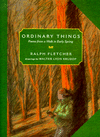April is the month when spring is truly upon us. It is prime time for getting outdoors, as we celebrate Earth Day, National Kite month, and in many states, Arbor Day. One of my yearly spring rituals is to pull out my copy of Ordinary Things: Poems From a Walk in Early Spring and read my way through the sights and sounds of spring. Once I've done this, I head out with my notebook for a spring walk of my own.
This lovely book by Ralph Fletcher contains 33 poems divided into three sections -- Walking, Into the Woods, and Looping Back. On the backside of each section divider is a poem describing that portion of the walk. Within each section readers find poems covering a range of natural and man-made objects, from fossils and ferns to litter and railroad tracks. There is much here that readers will relate to and recognize. Here is an excerpt from one poem I particularly like, entitled birds' nests.
Last year I wrote a three part series on exploring the natural world. In one of the posts I wrote this about focused observation.
When I was smallWhen I was growing up, we threw the debris from the lint trap in the yard for this very reason. Once the pieces disappeared, I wanted to spy on the nests nearby to see just what bits of nature had been included. With a good pair of binoculars, I could see the grasses, sticks, leaves, and in some cases, lint or some errant thread or string.
Grandma cut my hair
and tossed the clumps
onto our lawn.
"Birds will use it
to line their nests
and keep the eggs
safe and warm."
An amazing thing:
my ordinary hair
woven into a bird's
wild tapestry.
Last year I wrote a three part series on exploring the natural world. In one of the posts I wrote this about focused observation.
When I first begin to take kids outside, we do two activities designed to help them become better observers. In the first, I assign partner and give each pair a hula-hoop. The pair finds a spot in the yard, field or forest they would like to focus on. The hoop is laid on the ground, where it provides the boundaries for the observational field. How much can you find in this "small" circle? PLENTY! The first job should be to simply sit and look at all that is inside the hoop. Kids should sketch what they see in their journals. How many kinds of grass or vegetation are in the hoop? Knowing the names here isn't important, but rather recognizing that things look different. Encourage kids to get down on their knees and use their hands or a stick to part the vegetation and see what is beneath. A hand lens will help here. I often set timer this activity and then ask for groups to share what they have found. I also give groups the opportunity to repeat with a second plot so that they can see how different these small areas can be.The poems in Ordinary Things expand on this notion and demonstrate what can happen when readers look closely at the world around them. I recommend taking children on a nature walk with a journal in hand. Stop along the way for quick writing breaks. Encourage the children to focus on something they see and record a series of words or phrases to describe it. After a few minutes, move along to another spot. The idea here isn't to draw or photograph what's been seen, but rather capture the essence of the thing in words. Later on, all these descriptors can be used in writing poems about the walk.
Here are some resources that may help you think a bit more about some of these ideas.
- Learn more about Ralph Fletcher.
- Kristine O'Connell George has some observation tips for poets.
- You can learn when Arbor Day is celebrated in your state.

I love Ordinary Things by Fletcher, also. Thanks for highlighting it today!!
ReplyDelete